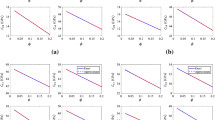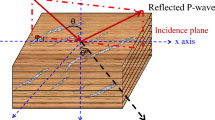Abstract
Understanding the effects of in situ fluid content and fracture parameters on seismic characteristics is important for the subsurface exploration and production of fractured porous rocks. The ratio of normal-to-shear fracture compliance is typically utilized as a fluid indicator to evaluate anisotropy and identify fluids filling the fractures, but it represents an underdetermined problem because this fluid indicator varies as a function of both fracture geometry and fluid content. On the bases of anisotropic Gassmann’s equation and linear-slip model, we suggest an anisotropic poroelasticity model for fractured porous reservoirs. By combining a perturbed stiffness matrix and asymptotic ray theory, we then construct a direct relationship between the PP-wave reflection coefficients and characteristic parameters of fluids (P- and S-wave moduli) and fractures (fracture quasi-weaknesses), thereby decoupling the effects of fluid and fracture properties on seismic reflection characterization. By incorporating fracture quasi-weakness parameters, we propose a novel parameterization method for elastic impedance variation with offset and azimuth (EIVOA). By incorporating wide-azimuth observable seismic reflection data with regularization constraints, we utilize Bayesian seismic inversion to estimate the fluid content and fracture parameters of fractured porous rocks. Tests on synthetic and real data demonstrate that fluid and fracture properties can be reasonably estimated directly from azimuthal seismic data and the proposed approach provides a reliable method for fluid identification and fracture characterization in a gas-saturated fractured porous reservoir.
Similar content being viewed by others
References
Ba J. 2010. Wave propagation theory in double-porosity medium and experimental analysis on seismic responses (in Chinese). Sci Sin Phys Mech Astron, 40: 1398–1409
Ba J, Xu W, Fu L Y, Carcione J M, Zhang L. 2017. Rock anelasticity due to patchy saturation and fabric heterogeneity: A double double-porosity model of wave propagation. J Geophys Res-Solid Earth, 118: 1949–1976
Bachrach R, Sengupta M, Salama A, Miller P. 2009. Reconstruction of the layer anisotropic elastic parameters and high-resolution fracture characterization from P-wave data: A case study using seismic inversion and Bayesian rock physics parameter estimation. Geophys Prospect, 57: 253–262
Bakulin A, Grechka V, Tsvankin I. 2000. Estimation of fracture parameters from reflection seismic data—Part I: HTI model due to a single fracture set. Geophysics, 65: 1788–1802
Batzle M L, Han D H, Hofmann R. 2006. Fluid mobility and frequencydependent seismic velocity—Direct measurements. Geophysics, 71: 1–9
Biot M A. 1956. Theory of propagation of elastic waves in a fluid-saturated porous solid—I. Low-frequency range. J Acoust Soc Am, 28: 168–178
Biot M A, Willis D G. 1957. The elastic coeff cients of the theory of consolidation. J Appl Mech, 15: 594–601
Brown R J S, Korringa J. 1975. On the dependence of the elastic properties of a porous rock on the compressibility of the pore fluid. Geophysics, 40: 608–616
Buland A, Omre H. 2003. Bayesian linearized AVO inversion. Geophysics, 68: 185–198
Chapman M. 2009. Modeling the effect of multiple sets of mesoscale fractures in porous rock on frequency-dependent anisotropy. Geophysics, 74: D97–D103
Chen H Z, Yin X Y, Gao J H, Liu B Y, Zhang G Z. 2015. Seismic inversion for underground fractures detection based on effective anisotropy and fluid substitution. Sci China Earth Sci, 58: 805–814
Connolly P. 1999. Elastic impedance. Leading Edge, 18: 438–452
Downton J E, Roure B. 2015. Interpreting azimuthal Fourier coefficients for anisotropic and fracture parameters. Interpretation, 3: ST9–ST27
Dvorkin J, Nur A. 1993. Dynamic poroelasticity: A unified model with the squirt and the Biot mechanisms. Geophysics, 58: 524–533
Gassmann F. 1951. Über die elastizität poröser medien. Vier der Natur Gesellschaft Zürich, 96: 1–23
Grana D, Della Rossa E. 2010. Probabilistic petrophysical-properties estimation integrating statistical rock physics with seismic inversion. Geophysics, 75: 21–37
Gurevich B. 2003. Elastic properties of saturated porous rocks with aligned fractures. J Appl Geophys, 54: 203–218
Han D H, Batzle M L. 2004. Gassmann’s equation and fluid-saturation effects on seismic velocities. Geophysics, 69: 398–405
Huang L, Stewart R R, Sil S, Dyaur N. 2015. Fluid substitution effects on seismic anisotropy. J Geophys Res-Solid Earth, 120: 850–863
Hudson J A. 1981. Wave speeds and attenuation of elastic waves in material containing cracks. Geophys J Int, 64: 133–150
Hudson J A, Pointer T, Liu E. 2001. Effective-medium theories for fluidsaturated materials with aligned cracks. Geophys Prospect, 49: 509–522
Liu E, Martinez A. 2012. Seismic Fracture Characterization. Netherlands: EAGE Publication
Liu F P, Meng X J, Wang Y M, Shen G Q, Yang C C. 2010. Jacobian matrix for the inversion of P- and S-wave velocities and its accurate computation method. Sci China Earth Sci, 54: 647–654
Martins J L. 2006. Elastic impedance in weakly anisotropic media. Geophysics, 71: D73–D83
Mavko G, Bandyopadhyay K. 2009. Approximate fluid substitution for vertical velocities in weakly anisotropic VTI rocks. Geophysics, 74: D1–D6
Mavko G, Mukerji T, Dvorkin J. 2009. The Rock Physics Handbook. Cambridge: Cambridge University Press
Pan X, Zhang G, Chen H, Yin X. 2017a. McMC-based nonlinear EIVAZ inversion driven by rock physics. J Geophys Eng, 14: 368–379
Pan X, Zhang G, Chen H, Yin X. 2017b. McMC-based AVAZ direct inversion for fracture weaknesses. J Appl Geophys, 138: 50–61
Pan X, Zhang G, Yin X. 2017c. Azimuthally anisotropic elastic impedance inversion for fluid indicator driven by rock physics. Geophysics, 82: C211–C227
Pan X, Zhang G. 2018. Model parameterization and PP-wave amplitude versus angle and azimuth (AVAZ) direct inversion for fracture quasiweaknesses in weakly anisotropic elastic media. Surv Geophys, 39: 937–964
Pan X P, Zhang G Z, and Yin X Y. 2018a. Seismic scattering inversion for anisotropy in heterogeneous orthorhombic media (in Chinese). Chin J Geophys, 61: 267–283
Pan X P, Zhang G Z, and Yin X Y. 2018b. Probabilistic seismic inversion for reservoir fracture and petrophysical parameters driven by rockphysics models (in Chinese). Chin J Geophys, 61: 683–696
Pan X P, Zhang G Z, Yin X Y. 2018c. Azimuthally pre-stack seismic inversion for orthorhombic anisotropy driven by rock physics. Sci China Earth Sci, 61: 425–440
Parra J O. 1997. The transversely isotropic poroelastic wave equation including the Biot and the squirt mechanisms: Theory and application. Geophysics, 62: 309–318
Rüger A. 1997. P-wave reflection coefficients for transversely isotropic models with vertical and horizontal axis of symmetry. Geophysics, 62: 713–722
Russell B H, Hedlin K, Hilterman F J, Lines L R. 2003. Fluid-property discrimination with AVO: A Biot-Gassmann perspective. Geophysics, 68: 29–39
Russell B H, Gray D, Hampson D P. 2011. Linearized AVO and poroelasticity. Geophysics, 76: C19–C29
Schoenberg M. 1980. Elastic wave behavior across linear slip interfaces. J Acoust Soc Am, 68: 1516–1521
Schoenberg M. 1983. Reflection of elastic waves from periodically stratified media with interfacial slip. Geophys Prospect, 31: 265–292
Schoenberg M, Sayers C M. 1995. Seismic anisotropy of fractured rock. Geophysics, 60: 204–211
Shaw R K, Sen M K. 2004. Born integral, stationary phase and linearized reflection coefficients in weak anisotropic media. Geophys J Int, 158: 225–238
Shaw R K, Sen M K. 2006. Use of AVOA data to estimate fluid indicator in a vertically fractured medium. Geophysics, 71: 15–24
Sil S, Sen M K, Gurevich B. 2011. Analysis of fluid substitution in a porous and fractured medium. Geophysics, 76: WA157–WA166
Stolt R H, Weglein A B. 1985. Migration and inversion of seismic data. Geophysics, 50: 2458–2472
Tang X M. 2011. A unified theory for elastic wave propagation through porous media containing cracks—An extension of Biot’s poroelastic wave theory. Sci China Earth Sci, 54: 1441–1452
Thomsen L. 1986. Weak elastic anisotropy. Geophysics, 51: 1954–1966
Thomsen L. 1995. Elastic anisotropy due to aligned cracks in porous rock. Geophys Prospect, 43: 805–829
Thomsen L. 2002. Understanding seismic anisotropy in exploration and exploitation. SEG 2010 Distinguished Instructor Short Course
Whitcombe D N. 2002. Elastic impedance normalization. Geophysics, 67: 60–62
Yang D H, Zhang Z J. 2000. Effects of the Biot and the Squirt-flow coupling interaction on anisotropic elastic waves. Chin Sci Bull, 45: 2130–2138
Yang D H, Zhang Z J. 2002. Poroelastic wave equation including the Biot/Squirt mechanism and the solid/fluid coupling anisotropy. Wave Motion, 35: 223–245
Yin X Y, Zong Z Y, Wu G C. 2014. Seismic wave scattering inversion for fluid factor of heterogeneous media. Sci China Earth Sci, 57: 542–549
Yin X Y, Zong Z Y, Wu G C. 2015. Research on seismic fluid identification driven by rock physics. Sci China Earth Sci, 58: 159–171
Zeng Q, Guo Y, Jiang R, Ba J, Ma H, Liu J. 2017. Fluid sensitivity of rock physics parameters in reservoirs: Quantitative analysis. J Seismic Explor, 26: 125–140
Zhang G Z, Chen H Z, Wang Q, and Yin X Y. 2013. Estimation of S-wave velocity and anisotropic parameters using fractured carbonate rock physics model (in Chinese). Chin J Geophys, 56: 1707–1715
Zong Z Y, Yin X Y, and Wu G C. 2012. Fluid identification method based on compressional and shear modulus direct iinversion (in Chinese). Chin J Geophys, 55: 284–292
Acknowledgements
The work was supported by the National Natural Science Foundation of China (Grant No. 41674130), the National Science and Technology Major Project (Grant No. 2016ZX05002-005).
Author information
Authors and Affiliations
Corresponding author
Rights and permissions
About this article
Cite this article
Pan, X., Zhang, G. Bayesian seismic inversion for estimating fluid content and fracture parameters in a gas-saturated fractured porous reservoir. Sci. China Earth Sci. 62, 798–811 (2019). https://doi.org/10.1007/s11430-018-9284-2
Received:
Revised:
Accepted:
Published:
Issue Date:
DOI: https://doi.org/10.1007/s11430-018-9284-2




